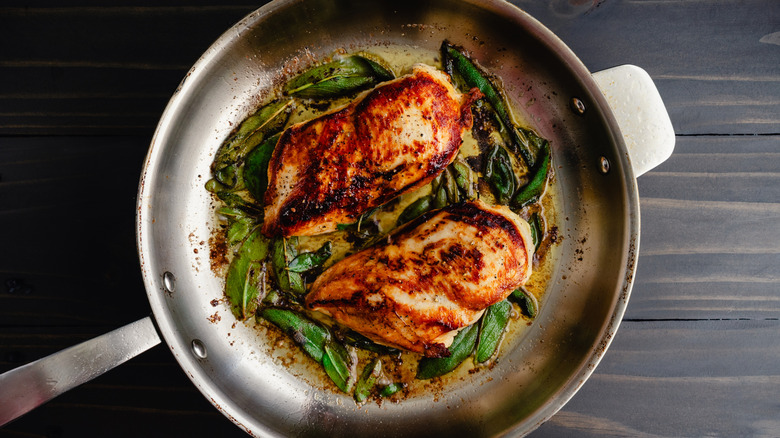
Veselovaelena/Getty Images
If you think chicken breast is boring, chances are your technique needs work. A nice long bath in a vat of brine followed by a quick sear in a hot skillet turns this everyday cut into juicy, golden chicken that commands attention at the dinner table. Brining, an ancient method of preserving meat in saltwater, lays the essential groundwork. Soaking the chicken breast in saltwater plumps it up with moisture, tenderizes the protein fibers, and carries seasoning deep inside so every bite tastes perfectly balanced.
Making chicken brine is easy and rewards patience. The salt-to-water ratio ultimately depends on how much chicken you're preparing. Once that base is set, you can layer on flavor with herbs, spices, fruit or vegetable scraps, garlic cloves, or even a splash of stock. Popular additions include sugar, rosemary, thyme, peppercorns, onion, carrots, and lemon slices. Some cooks even swirl honey into their chicken brine for a touch of sweetness.
Brine and pan-sear chicken breasts for a tender, flavorful meal

Candice Bell/Shutterstock
Timing makes all the difference with brining chicken. Thirty minutes delivers noticeable improvement, while an hour produces peak results. Go past two hours and the chicken risks becoming overly salty. Once brining is complete, pat the chicken completely dry. Surface moisture blocks browning, and browning builds character. A sprinkle of black pepper adds the final touch; extra salt is unnecessary.
For cooking, heat a heavy skillet over medium-high until the oil shimmers. Place the chicken in the pan and let it sear undisturbed for four to five minutes until caramelization sets in. Flip, lower the heat to medium, and cover with a lid so the chicken bastes in its own steam. Another four to five minutes brings it to 165 degrees Fahrenheit internally. Transfer the chicken to a plate and let it rest for at least 10 minutes before cutting, allowing the juices to redistribute evenly throughout.
With the right brine and sear, chicken breast adapts to countless recipes you'll make over and over. Pile it onto sandwiches, scatter it over salads, or serve it alongside roasted vegetables.



